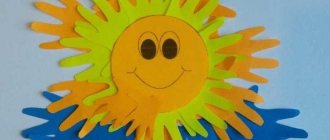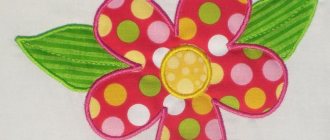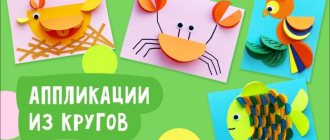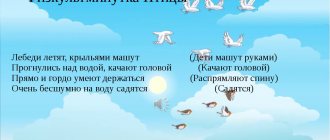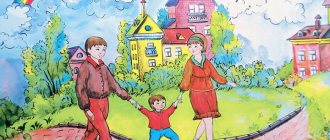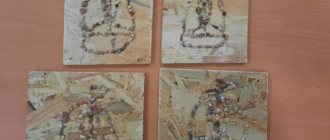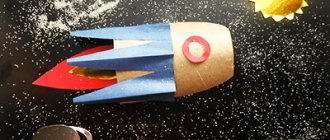Summary of a lesson on appliqué in the senior group “Train”
Software tasks:
— To consolidate knowledge on the topic “transport”, to cultivate respect for professions in transport.
— Improve the ability to carefully work with paper and glue, cut corners of squares and rectangles, create a holistic composition from elements, develop color perception and fine motor skills.
- Practice cutting out objects of the same shape from paper folded like an accordion.
— Continue to develop the ability to evaluate created images.
Equipment:
— Pictures depicting a variety of vehicles.
Materials for application:
— PVA glue, brushes, napkins, oilcloths, A4 size white cardboard with a pre-drawn railroad, geometric parts made of colored paper, scissors.
Preliminary work:
— Observation of transport, examination of subject and plot pictures on the topic “Transport”, didactic games on the topic, conversations about traffic rules, professions in transport, reading fiction on the topic.
Progress of the lesson.
1. Organizational moment.
All the children gathered in a circle: YOU are my friend and I am your friend! Let's hold hands tightly and smile at each other! (Children stand in a circle and give each other a smile.)
Smiling at each other, you gave a piece of good mood to your friend. When a good friend is nearby, then any trouble is not terrible. It's always more fun with a friend. You agree with me?
2. Motivational moment.
It’s especially nice to go on a trip with a friend.
— Would you like to go on a trip with your friend? (Children's answers.)
Tell me, what can you use to hit the road? (Children list types of transport.)
- Well done! You named many types of transport: water, air, and land.
D/i with the movements “Rides, swims, flies” (land transport - children hold the steering wheel, air transport - they depict the wings of an airplane, water transport - they show how they float).
- Well done! We did it!
— Now listen carefully to the riddle about one of the modes of transport: Iron huts
Attached to each other.
One of them with a pipe
Leads everyone with him. (Train.)
Looking at an illustration of a train.
- Let's see what the train consists of? In front of you is a steam locomotive - the main carriage, in which the driver sits and controls the train. Attached to the locomotive are carriages in which passengers travel. Look at what parts it consists of? (It has walls, wheels and windows.)
A train has a lot of cars, and such a train is called a train.
— Do you want to travel by train?
Then off to the carriages!
Physical exercise “A train is rushing.”
Choo-choo! Choo-choo!
The train is rushing at full speed.
(Children run in a circle one after another, placing their hands on the shoulders of the child in front.)
The locomotive is chugging.
I'm in a hurry! - it buzzes.
I'm in a hurry! I'm in a hurry!
(The first child makes circular movements with his arms bent at the elbows and pronounces the sound of a steam locomotive.)
3. Main part.
“Now let’s take our seats.”
Look, there is a railway, but the train has not yet arrived at the station. What to do? How should we go on our journey? (Children's proposals to make the train themselves.)
You have parts for our train on your table. Let's look at them carefully and think about what can be made from them.
We will make carriages from large rectangles, round wheels from squares, and windows from a narrow strip by folding.
The teacher shows how to do it. Afterwards, the children begin to work independently. Review the rules for safe handling of scissors.
4. Reflection.
- Guys, look how wonderful our trains turned out!
Now you can safely go on a trip!
Well done everyone!
Simple origami diagram for children
You can quickly make such a locomotive even while you are in line or on public transport with your child. It is enough to have a square piece of paper with you. At home, you can take one-sided colored paper in blue or light blue to simulate a modern high-speed train.
- Fold the square in half from top to bottom.
- Fold the bottom edges about 1-1.5 cm.
- Fold the top left corner inward. So, the simplest model is ready.
- To make it more recognizable, it is worth drawing windows.
A complicated version of origami
At first glance at this model, you can’t even believe that its carriages and locomotive are made from one piece of paper. However, this is true. All this was done thanks to a special pattern scheme once developed by Emmanuel Muzor. All you need to do is print out the diagram and, guided by the lines on it, make folds in the right places. If you wish, you can limit yourself to only a steam locomotive or still create carriages for it. There is also a more complicated version, in which the entire train is made from a long rectangle of paper, that is, the locomotive and cars are not separated in any way.
For those who have not yet used this method of folding origami, the model may seem complicated, but in fact it is not difficult to read the diagram.
- The straight line indicates the direction of the fold upward, that is, the edge should bend towards the top, and the dotted line, on the contrary, means the edge goes down. The result is a sort of alternation of ascents and descents.
- To accurately follow the diagram, you need to transfer it to a sheet of paper from which you plan to make a model.
- Without experience in assembling such figures, it is better to practice on a rough sheet.
Modular version of origami
Method No. 1
Such a design will only be possible for those experienced in modular origami or several people; it will take a lot of time, but the result is grandiose. In addition to paper, you will need a small piece of wire, glue, wooden axles for the wheels and the same base. Detailed assembly diagrams are shown in the photo below. First you need to prepare the required number of modules of different sizes.
Step-by-step instruction:
- For pipes you will need red modules of two sizes - 1/64 and 1/128 A4 sheet. The two shortest pipes of the eight rows are made up of 254 pieces of the first type. The longest of the 21 rows consists of 252 small modules and its fastening of 8 large ones.
- The spotlight consists of 96 large modules - 66 red and 30 yellow.
- For the boiler you need 756 blue parts of size 1/16A4, 175 of the same white and 20 pieces of 1/32 blue for fastening.
- The star on the boiler requires 50 red 1/64A4 parts, 5 of which are useful for connecting to the boiler.
- For large wheels you need 30 pieces of white 1/16A4, 70 of the same red, 40 white 1/64A4 and 20 red of the same size.
- Small wheel – 30 white 1/64A4, 50 red same and 40 white 1/128.
- Base – 776 blue 1/64A.
- Cabin - 231 blue 1/16A, 14 1/32 of the same color and 16 1/64A4.
- Cabin wing - 385 red 1/16A4, 104 1/16A4 of the same color, 50 blue 1/16A4 and 50 1/32A4.
- Drive – 75 red 1/64A4.
- Buffer – 13 red 1/4A4, 4 white 1/4A4, 1/8A4: 12 white and 15 red, 1/16A4: 20 white and 25 red, 1/32A4: 12 white and 41 red.
Method No. 2
The video below shows a version of a less detailed modular locomotive, consisting of convenient large parts.
Options for a motivating start to a lesson: conversations, fairy tales, poems, etc.
For an application on the topic “Trolleybus,” the teacher must think of a fascinating motivation.
You can have an educational conversation about means of transportation, especially highlighting urban transport. At the same time, posters and pictures are shown to children without fail.
Poster for kindergarten
Demo picture
It is necessary to examine a toy trolleybus with preschoolers, clarify its shape and key features - rods, rounded corners. The toy can “come to life” and ask the children to make friends for it - a whole fleet of trolleybuses. By the way, a car park is a wonderful solution for a collective composition.
toy model
You can also organize an interesting lesson by starting it with a fairy tale about a trolleybus.
From there you can also get motivation for productive activities.
For example, “The Tale of a Sad Trolleybus” by Elena Ponomarenko takes us to the city car park, where public transport lives. On New Year's Eve, the old trolleybus becomes sad, because everyone is waiting for the holiday, gifts, dressing up, but it has none of this: only garbage in the cabin, old torn up seats. Morozko appears and helps the trolleybus - he clears it of debris and gives its horns a beautiful blue-blue glow. The main character is happy from such a wonderful gift.
This activity is good to do shortly before the New Year. After telling the children a fairy tale, the teacher offers not only to make a trolleybus using applique, but also to give it a gift - decorate it with sparkling garlands and multi-colored lanterns (these elements can also be glued on or painted on).
Another “Tale about a Trolleybus” was written by Inna Aksenova.
Here the main character lives in a southern city and likes to imagine himself as some kind of animal or bird. For example, imagining himself as an elephant, the trolleybus began to move more slowly, and then passengers asked him to “turn” into an ostrich. Imagining himself to be a kangaroo, the hero considered the passengers to be his children, who were sitting in his bag. When it rained, the trolleybus “became” a hippopotamus, because they love water very much. But at night, in order to brighten up his loneliness in a deserted park, he convinced himself that he was a bear and was sleeping in his own den. The kind trolleybus driver Kostya approved of the trolleybus's fantasies and played along with him, but one day he went on vacation. To replace Kostya, the trolleybus was given another driver - the gloomy and always dissatisfied Uncle Petya. When the hero, out of habit, told him that today he was a gray wolf, Petya hit him hard on the steering wheel. The trolleybus was offended and refused to move. It was sent to the far corner of the park to be subsequently scrapped. Finally, Kostya returned from vacation. He found his dreamer, washed him, they sang a song about a pink elephant together and drove through the streets.
This fairy tale instills in preschoolers such qualities as kindness, condescension towards others, and teaches the value of friendship. After reading the fairy tale, you can offer the children a fantasy composition - make a trolleybus that imagines itself as some kind of animal, gluing on it characteristic details, for example, an elephant’s trunk and ears or long legs like an ostrich. The trolleybus can also be “transformed” into a hare or a peacock with a luxurious tail - in this case there is very much scope for children’s imagination.
Another work that can be recommended is “The Tale of a Little Trolleybus” by Irina Stepanova. The main character here is a baby trolleybus, which was recently made; it still smells of paint and the hands of the craftsmen who assembled it. He is enthusiastic and naive, always smiling, loves his job very much and does not understand why people curse when he raises huge fountains from puddles (after all, it is so much fun). The little trolleybus was bored among the grumbling buses and cars, he loved to look at the sky, clouds and sometimes tried unsuccessfully to take off - he left the line, and the angry driver swore at him and knocked on his sides. Over time, the baby grew up, stopped smiling, looked at the sky and sadly rolled along the road. One day he completely lost the desire to live - a trolleybus was driving along a bridge and decided to fall off it. But suddenly in the salon he saw a blue-eyed baby standing next to his mother and laughing. The child's eyes reminded him of the sky and those days when, inspired, he tried to fly. And the trolleybus began to smile again - it became the same as before.
After getting acquainted with this touching fairy tale, the teacher can invite the children to portray its main character. Moreover, the trolleybus needs to be given a human appearance - by gluing on eyes and a smile, or, conversely, giving it a sad look - by gluing on tears. Children will be interested in such work, because they really love to depict anthropomorphic creatures.
An illustration that can be used when reading fairy tales about a trolleybus
Eduard Uspensky
The trolleybus rode around the city all week. The trolleybus became terribly worn out in a week. And the trolleybus wants to lie in bed, But the trolleybus is forced to Run, Run, Run.
The trolleybus will carry, will carry People, People, People. And everyone hurries him: - Hurry, Hurry, Hurry! But no matter how much he hurried and no matter how hard he tried, No one thought to say thank you to him.
Here's the stop again, And here's the boulevard again. Runs, runs
In a hurry, in a hurry
And the tears just roll and roll out of the headlights.
https://deti-online.com/stihi/stihi-uspenskogo/trolleybus/
T. Umanskaya
Oh, what a long mustache! You can get hooked! Why don't you, my friend, shave in the morning!? - What are these strange words? I don’t have a mustache, but two! “The most important thing for us is the mustache!” - Everyone will say troll-boo-sy!
A. Chesnokov
The teacher asked a rebus: Are there horns, but not a lamb? We answered: trolleybus
, The best transport for first-graders! On the weekend, what to do if the blizzard howls a song? There is nothing more pleasant than riding a trolleybus in winter. Across the Black River, Along the Peat Path. The stove warms the legs from below, and the horns stretch out from above. In a whirlwind, past the angry snowdrifts, into the open space covered with snow, quenching the passion of the road, reveling in the hot run. The moment of parting comes: To the park for him, and for us to the yard, Goodbye, goodbye, Miracle Yudo number forty.
G. Shmonov
Once upon a time there was a trolleybus
, Bright red, mischievous, In the mornings he loved to run along the cobblestone streets. He didn’t like stops, He loved rainbows in the sky, He carried passengers from the station to Sosnovka. On Sunday, he came to the autumn forest to pick mushrooms, from raspberries, he respected jam very, very much! And he was friendly with the kids. He took them to the river in a crowd, brought lunch and dinner, and then took them home. Someone will say - “I don’t believe it! There are no trolleybuses like this!” Come. I checked. And I came up with this verse.
You can ask preschoolers a riddle about a trolleybus:
Day after day, around the circle, the mustachioed beetle rushes into the distance. He doesn't catch worms and doesn't eat sedges. Straight from the sky, from the wires, Drinking electric currents. If we don’t feed him the Miracle Send-Off, He won’t carry us around, wiggling his mustache.
https://www.numama.ru/blogs/kopilka-detskih-stihov/stihi-pro-troleibus.html
Physical education sessions, which are mandatory before children’s independent creative work, should also be related to the topic of transport. For example, the following are suitable:
"Bus"
"Transport"
Options for finger exercises about transport:
Let's bend our fingers - Let's call transport: Car and helicopter, Tram, metro and plane. We clenched all our fingers into a fist, named all types of transport.
Playing with fingers. Connecting all fingers with the thumb in turn, starting with the index, for each stressed syllable:
Bus, trolleybus, car, tram -
Don’t forget about them on the street (change of hands).
In the seas - ships, icebreakers, vessels,
They very rarely come here.
https://childschool.ucoz.ru/blog/palchikovaja_gimnastika_fizkultminutka_zagadki_transport/2014–08–01–1235
Ready-made templates for cutting
This technique for making crafts has its advantages - it saves time, plus you don’t need experience, the ability to draw and work with folds and modules. The disadvantages are obvious - the lack of opportunity to personalize the craft, to show creativity, and such a locomotive is unlikely to be appreciated at an exhibition or competition.
However, ready-made templates can come in handy. All you need to do is print it on a color printer, cut out the parts and glue them in the correct order. And for creativity, you can circle these parts on a white sheet and draw your own version on it.

